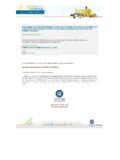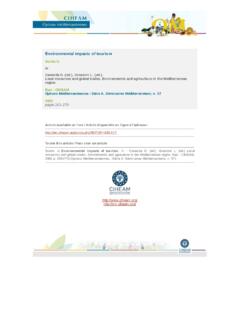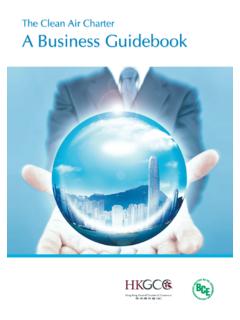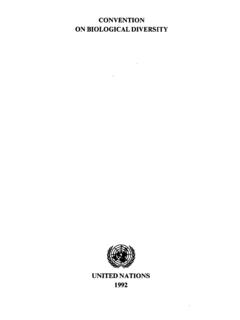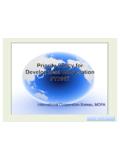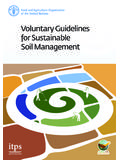Transcription of Extension education in agricultural and rural …
1 Extension education in agricultural and rural development : Role ofinternational organizations - the FAO experienceGaaya P. (ed.). La vulgarisation, composante du d veloppement agricole et rural : actes du s minaire deGrenadeMontpellier : CIHEAMC ahiers Options M diterran ennes; n. 2(4)1994pages 33-45 Article available on line / Article disponible en ligne l adresse :--------------------------------------- ---------------------------------------- ---------------------------------------- ---------------------------------------- ----------- ---------------------------------------- ---------------------------------------- ---------------------------------------- ---------------------------------------- ----------To cite this article / Pour citer cet article--------------------------------- ---------------------------------------- ---------------------------------------- ---------------------------------------- -----------------Gaaya A.
2 Extension education in agricultural and rural development : Role of internationalorganizations - the FAO experience . In : Plaza P. (ed.). La vulgarisation, composante dud veloppement agricole et rural : actes du s minaire de Grenade . Montpellier : CIHEAM, 1994. p. 33-45(Cahiers Options M diterran ennes; n. 2(4))----------------------------------- ---------------------------------------- ---------------------------------------- ---------------------------------------- --------------- Options M diterran ennes, vol. 2, n 4 Abstract. Since its founding conference session in 1945, Extension has appeared in the agenda of most FAO'sconferences, consultations or meetings (especially that of the World Conference on Agrarian Reform and RuralDevelopment WCARRD, in 1979). However, there are still many problems and issues to require attention.
3 This article outlines: the capabilities and limits in FAO's assistance to agricultural Extension , the kinds and scope of FAO's activities in support of agricultural Extension , the problem areas to be addressed in achieving effective and affordable systems. Strategies and future directions are rural development Extension international organizations Educational The agricultural Extension ConceptWhat is understood by the expression agricultural Extension in terms of functions encompassed, purposes,programme content, and clientele has varied from country to country over time. Out-of-school educationmay be the only function or one of several, such as supply of inputs, arranging credit and marketing facili-ties, collecting statistics, and enforcing regulations. The purposes may be to increase production, to increa-se income, or even to include actual improvement of family living (made possible by the increased income)and education for self-reliance in seeking and effecting improvements in the future.
4 Programme contentmay comprise production of a particular crop or all crops, livestock, forestry, or fisheries, singly or in somecombination. Coverage of any of these subject-matter areas may include marketing, other economic andmanagement aspects and, in the most comprehensive system, all of these plus conservation, maintenanceof environmental quality, and social considerations such as nutrition, population growth, and general impro-vement in family life. The clientele addressed may be all men and women, adult and young farmers, oronly some of these categories of rural producers. A concept of agricultural Extension widely used in FAO is one included in the FAO publication AgriculturalExtension: A Reference Manual(Swanson, 1984). agricultural Extension is a service or system whichassists farm people, through educational procedures, in improving farming methods and techniques,increasing production efficiency and income, bettering their levels of living and lifting the social and educa-tional standards of rural life.
5 A definition, revised in the light of the World Conference on Agrarian Reformand rural development (WCARRD) and other developments since 1973, might refer specifically to men,women, youth, and the most disadvantaged groups in general, encouraging and involving rural people sown organizations, enhancing individual and collective self-reliance, and environmental and more than forty five years, FAO has been supporting farmer learning. Governments around the worldare being assisted in establishing and operating Extension systems and programmes within the frameworkof national economic and social policy, government structures, and the availability of natural and financialExtension education inAgricultural and RuralDevelopment: Role of international Organizations ~ The FAO GaayaFAO, Institutions and Agrarian Reform Division, Rome (Italy)CIHEAM - Options MediterraneennesCahiers Options M diterran ennesresources.
6 The rights, socioeconomic circumstances, and needs of the intended beneficiaries are additio-nal determinants of the nature of assistance rendered. Diversity among and within nations in all these fac-tors has meant that there could be no single universally applicable approach to the provision of Defining FAO s Role in agricultural Extension as a Contribution toAgricultural and rural Development1. The MandateAuthority and broad guidelines for FAO s work in agricultural Extension emanate from decisions of thegoverning body, the Conference, and are influenced by discussions in its subsidiary bodies and in otherpolicy-level conferences, consultations, or meetings. Extension has had a prominent place in policydebates in these forums throughout FAO s history. Members of the Interim Commission on Food andAgriculture, which functioned between the 1943 Hot Springs Conference on Food and Agriculture and theformal establishment of FAO in Quebec in 1945, recognized the importance of Extension , both implicitlyand explicitly, in preparing the Preamble and Articles I and II of the FAO Constitution.
7 In the absence of aneffectively functioning Extension system, it would be impossible to achieve the goals established for theOrganisation in the Preamble: raising the levels of nutrition and standards of living of the peoples undertheir respective jurisdictions: securing improvements in the efficiency of the production and distribution ofall food and agricultural products; bettering the conditions of rural recognition of the role of Extension is explicit in portions of Articles I and II, describing the functions ofthe organization . Article I states: The Organisation disseminate information relating to nutrition,food and agriculture. In this Constitution, the term "agriculture" and its derivatives, include fisheries, marineproducts, forestry and primary forestry products.
8 In Article II (b) the reference is more direct: TheOrganization shall promote and ..recommend national and international action with respect to ..(b) theimprovement of education ..and the spread of public knowledge of nutritional and agricultural science the adoption of the constitution by the First Session of the FAO Conference, the founders of FAO pro-vided the mandate for work in agricultural The Policy GuidelinesSince the founding Conference session in 1945, Extension has appeared on the agenda for most sessionsof the General Conference, Council, and Technical Committees on Agriculture, Forestry, and Fisheries andthe regional conferences. Additionally, global conferences and technical meetings, dealing in part withextension, have been organized by FAO. Examples of such meetings are the Second World FoodCongress, held in the Hague in 1970; the World Conference on agricultural education and Training, held inCopenhagen in 1970; the WCARRD, held in Rome in 1979; and the Global Consultation on AgriculturalExtension held in Rome in 1989.
9 Recommendations from these forums have gone to the Council andConference for formal endorsement and subsequently to headquarters divisions to serve as directives orguidelines in carrying out their most significant event in giving impetus and direction to work in agricultural Extension and indeed toFAO s work as a whole, was the WCARRD. The principles and programme of action prepared placed spe-cial emphasis on growth with equity and poverty alleviation, on the need for involvement of the high propor-tion of the rural population women, landless producers, the poorest and smallest farmers, youth whohave been largely bypassed and failed to benefit from past development efforts. The guidance for exten-sion work is summarized in The Peasant s Charter and Declaration of Principles and Programme of Action(1981).
10 education , including and Extension services are fundamental needs for human development inrural areas and also for expansion and modernisation of rural No less essential is the creationand expansion of training and Extension networks for both men and women to develop and improve skills34 CIHEAM - Options MediterraneennesCahiers Options M diterran ennes35and to increase productivity and income-generating capabilities. There is also need for establishment ofeffective linkages between Extension and problem-solving research. In view of the great urgency of theseneeds and the magnitude of the task in relation to the resources of developing countries, low-cost tech-niques of education and training for short periods merit close same Conference called for particular action in respect to women: Establish special recruitment and training schemes to increase the number of women in the training andextension programmes of development agencies at all levels, including professional fields from whichwomen have been traditionally excluded; Broaden the range of agricultural training Extension programmes to support women s roles in activities ofagricultural production, processing, preservation and marketing.
